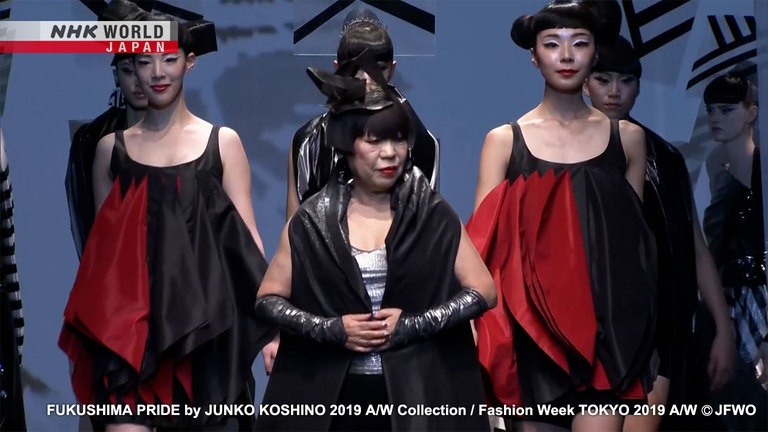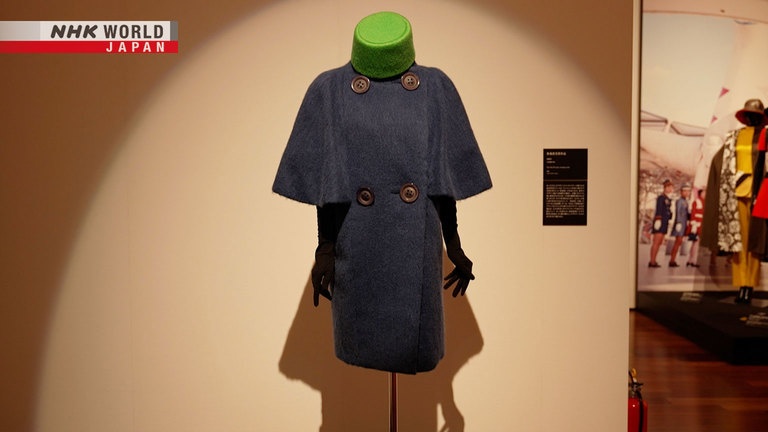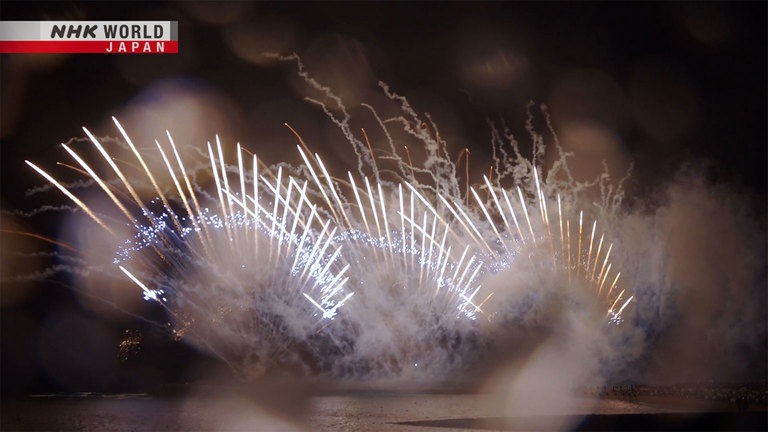Junko Koshino: Encounters Inspire Creativity
Designer Junko Koshino has astonished Japan's fashion scene for over 60 years with her out-of-the-box creations. We learn what continues to spur Koshino's passion for design.




Transcript
It was wonderful.
I wanted to do something utterly new.
Today's guest is designer Junko Koshino.
In 1978, she debuted her designs at Paris Fashion Week,
where she continued to hold shows for 22 consecutive years.
Her designs predominantly feature geometric shapes like squares and circles.
Her avant-garde creations have been highly acclaimed.
But her work isn't limited to apparel.
She's also the creative force behind this fireworks show in Okinawa.
Encounters inspire creativity.
First encounters are unforgettable.
They allow you to grow.
Her older sister Hiroko and younger sister Michiko are also world-famous fashion designers.
The starting point for all three sisters was their mother, who ran a dressmaking shop.
Our host Robert Campbell joins Koshino as she revisits her hometown.
- Everyone's waving.
- Oh, hi.
Take care.
Koshino continues to move relentlessly forward in pursuit of beauty.
What is it that fuels her passion?
We hear from the designer herself, on today's Face to Face.
This exhibition showcases the 60-plus years of Koshino's career.
From collections that graced runway shows...
To costumes worn on stage.
Koshino's creative breadth is limitless.
It all began with this design she created at the age of 19.
It made her the youngest-ever winner of a prestigious award considered to be the gateway to success for young designers.
Her design used high-pile fabric, and features large buttons as accents.
- It would sell now. It's not dated.
- I'd love to wear it.
My customers say that, too.
Is it a cloak, a dress, a coat?
Who knows?
It defies description,
which adds to its appeal.
Lovely fresh color.
I love this shade of blue.
But I was living in a tiny apartment.
As I cut, the fibers shed.
Blue everywhere!
On the tatami?
I could hardly breathe. But those
are fond and cherished memories.
These are the uniforms she designed for the 1970 World Expo held in Osaka.
They made Koshino, then an up-and-coming designer, into a household name.
I was in my late 20s.
I designed what I wanted to wear.
Mini dresses were popular then.
But the tie?
Striking, isn't it?
Very innovative at a time
when women didn't wear ties.
It's like a huge scarf tie.
The venue was like a stage.
You got to meet people from all over,
and take on new challenges.
Everyone had fun communicating with
people they'd never met before.
It must have felt explosive. Cultural,
economic, personal interactions.
Encounters inspire creativity.
First encounters are unforgettable.
They allow you to grow.
One source of inspiration for Koshino is the concept of "opposites."
I got pregnant in 1980, and as my
baby grew, my belly became round.
It held a person inside. A universe.
I'd been showing at
Paris Fashion Week since 1978.
That year I only made round clothes.
Then I moved on to squares
as a contrast.
So, it was a process of evolution
rather than a concept.
The world is made up of opposites:
East and West, North and South Poles.
The colors of black and white.
I chose the opposite colors
of red and black.
Design is about striking a balance
between two opposites.
New design sketches.
I always draw the hairstyle
and makeup first, before the design.
Why?
Because the hair, makeup,
and clothes need to be integrated.
These garments are made from kimono fabric, yet are tailored like Western dresses, and can be put on in less than a minute.
Koshino's ideas are bold, but practical.
The lifestyle and mentality of her hometown, Kishiwada in Osaka, have had a strong influence on her mindset.
This was where her mother, Ayako, once ran a dressmaking shop.
After being widowed, the tenacious Ayako raised her three daughters alone.
This used to be a dressmaking shop.
The same site?
Yes, isn't it tiny?
As a kid, I drew all over the tiles
with chalk. People would watch!
I just couldn't stop.
Hello.
The dressmaking shop has been turned into a casual dining restaurant and gallery.
Wow, so your mother used this?
Yes, in her final years.
What was she like?
She'd work till 3 AM every day.
I grew up watching her work.
She was always busy with customers.
There was one event that Koshino and her mother looked forward to each year.
The Kishiwada Danjiri, an exciting and high-energy festival.
Koshino remembers helping to pull the festival floats during her childhood and adolescence.
Her passion for the Danjiri festival led her to design tubular costumes inspired by its lanterns.
Upstairs was a prime viewing spot.
It was thrilling to watch
the floats speed past.
Everyone wants to watch from here.
That's really why we've kept the store.
The restaurant serves one of Koshino's favorite dishes.
She's my relative.
- Hello.
- Welcome.
I'd wanted to come here.
It's a nice place.
Thanks to her.
- This is our special Danjiri Curry.
- Oh, yes.
Everything is good here.
But I always order the curry.
It's mild.
It has beef tendon and konnyaku.
It's good.
A rolled omelet.
My mother's specialty.
- Was it sweet?
- No.
Mom liked to drink,
so she made it savory.
This isn't sweet, either.
She found the time to cook?
She was fast at everything.
She'd shop at the market just around
the corner, come back, and cook.
A total of one hour to shop,
cook, and eat.
She did everything.
Their next destination is a nearby Noh theater.
Lovely.
Nice and intimate.
Tucked away.
Pardon us.
Noh masks are on display.
- Nice atmosphere.
- The seats surround the stage.
- Do you enjoy Noh?
- Yes, quite often.
Noh is a highly stylized form of theatre.
It's performed on a special stage by actors wearing masks and elaborate costumes, and dates back over 600 years.
In 2020, Koshino created costumes for a performance that brought together Noh and fashion.
She expressed both the traditional aesthetics of Noh theater and modern sensibilities.
You create a fusion of Japanese
tradition and modern fashion.
I once invited the Iemoto grand
master as a guest on my radio show.
He brought a huge parcel.
I reminded him that the listeners
couldn't see what he brought.
"Obviously," he said.
I asked what it was,
and he opened it on-air.
In the booth?
He took out a 300-year-old Noh mask.
He'd brought it for me to wear.
I'd never put on a Noh mask before.
It was surprisingly light.
I wore it till the end of the show.
Did it change your perspective?
You can only see through
the 1 cm wide holes.
You must turn your head to see.
Because your vision is so limited,
you focus on one point.
The Kanze Iemoto is a character.
Yes, and this led to an invitation
to do a show at the Noh theater.
I felt intimidated by the idea.
I'd never done anything like it.
But I agreed to take on the challenge.
It's no easy challenge you took up.
It was an interesting encounter.
Our fields, our genres, were utterly different.
Very new to each other.
That initial awkwardness is
something to celebrate.
The Iemoto says Noh is constantly
tackling new challenges.
That's what has kept it alive
for over 600 years.
That's truly remarkable.
I wanted to show the gods
of wind and thunder.
I used leather for the Noh costumes.
I kept the foundation,
but played with the material.
The jacket is Nishijin gold brocade.
But the trousers are made of
cutting-edge synthetic fiber.
I wanted to strike a balance.
Did you match fabric to movement?
I saw no reason to upset
the long history of Noh.
But I wanted to breathe
new life into it.
A school by a castle? How nice.
The neighborhood hasn't changed.
This is the main entrance.
Koshino and Robert visit Koshino's high school, founded in 1897.
- Everyone's waving.
- Oh, hi.
You're all first-years?
He's famous.
What do you think of her?
She has a strong aura.
- What club are you in?
- Photography.
Basketball.
Guitar.
- What about you?
- Table tennis.
I was, too.
You knew?
You said so at the entrance ceremony.
That's why I joined.
Wow! I was also in the art club.
I see.
The students are wearing uniforms designed by Koshino.
Her redesign was the first in 72 years.
Notice the color of the tie.
It's green.
Turn around and turn up the collar.
It's green. Nice.
A subtle accent.
It's also panel-tailored.
- Is it comfy?
- Very.
You have to wear it for 3 years.
So it's a bit big.
You'll grow into it.
Fix your tie.
Personal advice from the designer
herself. That's something.
The tie has the school emblem.
Hello! Oh, what a welcome!
Let's take a photo together.
Gather round.
Say cheese. Okay.
Take care.
Brings back memories.
It's fun.
- Hello.
- Pardon us.
Hello. This is Robert Campbell.
- Nice to meet you.
- I'm Ueki Nobuhiro, the principal.
The school principal shares the initial sketches of the uniforms Koshino created.
Uniforms can't pay mind
to passing trends.
It's a municipal school,
so there are certain conventions.
So, I focused on the details
to express the school's identity.
That includes using muted green
as an accent color.
The design is the same for
all students.
Students can wear skirts or pants.
- Really?
- Yes.
That's nice.
We wanted to embrace diversity by
moving toward unisex uniforms.
How have parents responded?
Very favorably.
There's something else that Koshino wants to show Robert.
These two.
These are the posters Koshino designed as a student for the annual school festival.
Her designs were chosen two years in a row.
Rather Picasso-esque.
Yes. Do you remember this?
How could I forget?
They're mind-blowing.
Bursting with energy.
That one's my elder sister's.
Wow, a Hiroko Koshino!
She graduated before me.
What is fashion?
Koshino has traveled around the world in search of the answer.
You're too tense.
Lower your shoulders.
In Cuba, she held a fashion show with local models, dancers, and musicians.
It was a fusion of Cuban culture and Koshino's unconventional design flair.
Later, in Myanmar...
Koshino held a similar event, conveying the freedom of fashion
by interpreting it through traditional local culture and dress.
Japanese people are quite ingenious.
We're very good at coming up with
new ideas and forms of expression.
It stems from our sensibilities.
The aesthetics of subtraction.
In Europe, I think they prefer to add.
Japanese sensibilities
are simple and chic.
The beauty of empty space.
There's growing concern over
waste produced by fast fashion.
A sign of the times.
What are your thoughts on
fashion and SDGs?
Your jacket is a sustainable design.
It's a patchwork of scarves that
my father bought in Ireland.
I had it made in Tokyo as a keepsake.
You're wearing your family's history.
Instead of throwing the scarves away,
you put them to good use.
- I'm very impressed.
- Thank you.
You had the sense to reuse with style.
That may be the key
to achieving SDGs in fashion.
You also design fireworks, right?
I imagine the night sky to be
a huge black canvas.
So I design on black paper.
Fireworks designed using the night sky as a canvas.
Koshino is a lecturer at a university in Kyoto.
The students learn about traditional crafts, architecture, and art in a multidisciplinary environment.
Today's workshop covers designing fireworks.
I was thinking of sparklers.
They fall like droplets.
Wouldn't it be fun to create
that on a huge scale?
I like your idea.
An explosion of bright, delicate
sparklers across the sky.
The droplets look good. Color next.
What sort of colors?
The simpler the better.
It's about subtraction.
People tend to layer it on.
But less is more in terms of beauty.
I need to study more
in order to subtract.
You'll get there.
Koshino evaluates the 20 works submitted by the students.
I think it'd be even better if you
could see it open up like a fan.
It would be fun to create
footprints in the sky.
Like a stomping giant.
It'd go well with cute music.
This would be like a work of art
all across the sky. Very beautiful.
Have you always been
in pursuit of beauty?
Yes. But there's no beauty
in repetition. It's boring.
People are stunned by things
they've never seen before.
Maybe that's what beauty is.
It has a lot to do with experience.
Everything seems new to youngsters.
I want them to do things
they've never done before.
It's all about visualization.
Color, form... their imagination
has free rein.
Preconceptions and rigid thinking
get in the way.
They stop you from discovering
and exploring the unknown.
Apathy seems to be widespread
among young people today.
They receive too much. See too much.
It's easy to lose yourself
in the flood of information.
Lose your identity.
Data is history. It's not about
the unpredictable future.
What matters is the present. Nobody can
predict what a new day will bring.
If your work is based on the past,
it's just repetition.
You're in constant movement.
You create new expressions and
values in keeping with the times.
Always looking ahead.
It boils down to understanding
where you stand.
How does that work?
You start by respecting others.
I have a favor to ask you.
Will you guide me around a town
that still has an Edo-period feel?
That period was isolated and
free from foreign influences.
It gave birth to a culture
that was uniquely Japanese.
You know so much about it.
Your extensive research and outside
perspective make you an expert.
I've wanted to ask for ages.
Definitely.
- I'm looking forward to it.
- Glad to hear it.